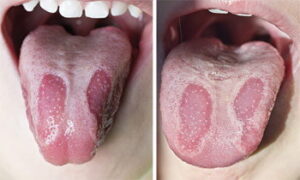Geographic Tongue

Geographic tongue is characterized by harmless lesions, or patches, that can suddenly materialize on the tongue’s top surface. The condition gets its name from the physical appearance of the lesions, which resemble smooth, red islands, possibly rimmed with white. Their smoothness comes from the absence of the tiny bumps or “papillae” that normally cover the entire surface of the tongue. These variations in color and texture give the whole tongue a map-like appearance.
The pattern on the tongue can change daily as the lesions appear to move or migrate, healing in one spot only to reappear in another. That’s why the medical term for this condition is benign migratory glossitis. It’s scary looking, but does not compromise a person’s health.
Discomfort from the condition can sometimes be relieved with over-the-counter pain relievers; mouthrinses containing anesthetics, antihistamines, or steroids; and by avoiding certain irritants such as tobacco, alcohol, and foods that are spicy, salty or acidic.
No one knows exactly what causes geographic tongue. Some factors that may play a role include vitamin B deficiency, irritation from alcohol or spicy foods, and genetics.
This condition can be diagnosed simply by examining your tongue; laboratory tests are usually not necessary. Geographic tongue normally resolves on its own, but a dental professional should be consulted if you notice any changes in your tongue’s appearance.
